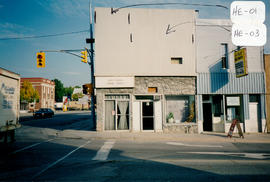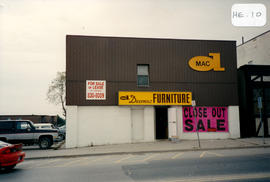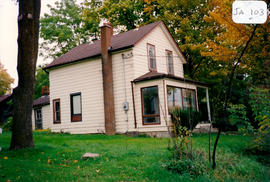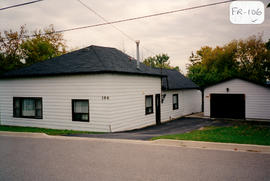The fundraising for a new building for the Bradford Public Library reaching the $75,000 mark.
Bradford West Gwillimbury Public LibraryBradford West Gwillimbury
1205 Archival description results for Bradford West Gwillimbury
The building located at 1 Holland St. East (on the northeast corner of Holland and Barrie Streets) is part of what is known as the Green Block. The structure was originally owned by Mr. Green, who lived with his family on the west side of Church St. in the hotel. The Masonic Hall is still found upstairs at this location in 2014. (1, 2)
Many businesses have been located at 3 Holland St. East (on the northeast corner of Holland and Barrie Streets) over the years. They include a grocery store, a boot and shoe shop (run by Charlie Wilson), an insurance company (that was later run by Fred Cook), a delivery service for C.N.R. (first by horse and buggy, then later by Model T Ford), a hamburger stand (run by Harold ‘Butch’ Boyd), and a telephone office. The first private telephone came to Bradford in 1885 and was run by a number of businessmen. There were ten phones only for Bradford. A garage was later added at the back at the laneway for trucks and cars. (1, 2)
The building located at 1 Holland St. West was originally built as a hotel (Central Hotel, Uneeda Hotel, H. Hulse Hotel). Tom and Len Saint worked on the construction of the building. George Webb ran the hotel for a while before he moved to Saskatchewan. Tom Bell was the manager for many years until he retired and moved to the east side of Simcoe Street. Around 1917 it became the Imperial Bank of Commerce. A large safe and living quarters for the bank staff were located upstairs. The entrance to the apartment was on the west side of the building. John McDowell and his family lived here in the 1930’s. The bank was robbed by the notorious “Boyd Gang” in the 1940’s. At one time the front offices were used by the police, and the back offices were used by Mr. Scanlon (a lawyer). The bank closed in 1972 and was moved further west on Holland Street. This building then became a real estate office, a convenience store, and as of 2014, the Coffee Culture Café. (1, 2)
George JacksonThe mid-block building located at 10 and 12 Holland St. West was built in the Ontario Vernacular style around 1872-1899. The two-storey, commercial, detached ‘row’ building had a narrow rectangular plan with an asymmetrical organization. ‘Main street’ frontage with a typical storefront façade was located at the street line. The plain façade was characterized by a high, flat, ‘boomtown’ façade and cornice with brick dentils. The two bay-façade each had its own entrance and storefront. Existing doors and storefronts are not original. The original, large, second-floor windows (characterized by segmented arch openings and concrete sills) have been partially bricked in, but are still visible from the brick voussoirs. The building has masonry construction with brick cladding and a flat, built-up tar and gravel roof. (1, 3)
The west side of the building (10 Holland St. West and the location of Pizzaville in this 1995 photo) was once the site of a drugstore run by W.L. "Billie" Campbell. Fred Cook helped him for a number of years. Billie’s son, Lou, and druggist Clarence Ritchie took over the business. Eventually Clarence Ritchie ran it on his own before he retired. Fred McKay sold phonographs on the upper floor and there was a pool room run by James Ferguson. The Salvation Army held services here in the 1930’s. (1, 2)
Sutherland’s Grocery Store was once found at 12 Holland St. West (site of Karen’s and Tina’s Flowers in this 1995 photo). Alec Sutherland was a baker. He had a bakeshop on the south side of Simcoe St. that was run for many years by his daughter Jessie and sister Mrs. Bessie Ryan (and her daughter Betty). They eventually retired and moved to St. Catherine’s. There were living quarters upstairs. William Compton and his wife bought the store and ran it as an IGA grocery store. Gord and Marilyn Compton later took over the store. They built a new store on John St. (where Frank Kilkenny’s house had been). The Comptons’ store eventually moved to what was known as the IGA plaza (located at the corner of Collings Ave. and Holland St. West). As of 2014, 12 Holland St. West is the site of The Holland Bloom florist shop. (1, 2)
The building located at 10 Holland St. East in this 1995 photo is not the original structure on this property. That building was destroyed in the big fire of 1871 and the space stood empty for many years. A man from Aurora hired Art and Leonard Saint in 1936 to build a movie theatre on the vacant lot. It was to be a winter and fall project after they finished building the Post Office on Barrie Street. The Holland Theatre, as it became known, was completed in 1937. It had a basement, a front projection room upstairs, a cement foundation, cement floors and red, block, tile walls. All of the quicklime that was used was hauled in from Hagerville and made into mortar in the basement. The mortar contained camel, goat, and cow hair which came from Colles’ Leather business in Aurora. A steel, suspended lath was plastered in the ceiling. The roof was flat and sloping and the stage was at the rear. The owners in the 1940’s and early 1950’s were Mr. Rees and Mr. Hobberlin. George Carson bought the theatre after WWII. The structure later housed many businesses, including a Deemac Furniture store. The building is currently (2014) unoccupied. (1, 2)
George JacksonDr. Gilbert Blackwell’s House is located on the southwest corner of Barrie and Joseph Streets at 72 Barrie Street. His office faced Joseph Street. The structure was built in 1935 by builder Art Saint in the Arts and Crafts style.
The simple form has an asymmetrical façade and a rectilinear plan. A broad, steeply-pitched, bell-cast roof with a centre dormer extends down to reduce the scale of the building from the street. It also covers the original front porch (which has been enclosed). The structure has wide window openings with low floor to ceiling heights. A wide band of windows across the front of the dormer emphasizes the horizontal lines and massing of this house. Smaller, second-storey windows in the front dormer are offset from the ground-floor windows and have plain, wood sills and trim. The original arched openings in the front porch have been infilled and new windows have been installed. Brackets support the cornice at the roof and there is a central, brick chimney. The house has wood frame construction, stucco cladding and a painted, concrete foundation. A mix of exterior cladding materials is common to this style. The windows, awnings, and the one-storey, rear addition are not original. According to the 2000 inventory, the house is in good condition with some original features. (1, 3)
The mid-block building located on the north side at 101 John St. East was built pre-1900 in the Gothic Revival Cottage style. Originally, there was a woodshed across the back. It was the home of Mrs. Leduc or Mrs. Paul Courier, a French descendant from the old lumber mills. She wove rugs and blankets and repaired clothing. After her death the house was rented. Howard Robson and his wife lived here with part of their family, namely, Alvin, Garret and Phyllis. The building then became the home of Henry Pringle and his wife Joan. He was a retired railroad section man and owner of a garage on Holland Street. It was still the home of Joan Pringle when this photo was taken in 1995.
The 1½-storey, three-bay house has a rectangular plan, a centre hall, and a symmetrical façade.
Its medium-pitched, gable roof has a centre gable over the entrance. The building has small windows with low floor to ceiling heights. There are double-hung windows in rectangular openings with plain, wood frames and sills. The entrance porch, its windows, screen door, and the metal awnings are not original. A brick chimney at the exterior wall is also a recent reconstruction. The building has wood frame construction, vinyl siding and a parged stone foundation. Originally, the cladding was stucco. According to the 2000 inventory, the building’s basic form is camouflaged by the later additions. (1, 2, 3)
This house is located at 103 James Street. (1)
George JacksonThe house located at 105 Barrie St. was once the home of Dennis and Mrs. Nolan, their son James (a car dealer and salesman), and daughters Connie (a teacher at Bradford High School) and Aileen (also a teacher). Dennis Nolan was a Model T. Ford dealer in Cookstown as well as a noted, prize-winning, honey producer. He was also the reeve of Bradford, involved in the drainage of the Holland Marsh, and he worked marshland. At one time Dennis owned the town’s water works. (1, 2)
George JacksonThis house is located at 106 Frederick Street. (1)
George Jackson








